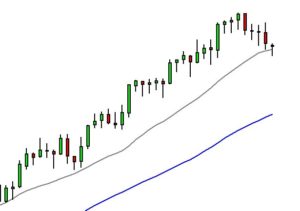Commodity swing trading is usually considered high risk investing. That is not necessarily so when utilizing candlestick signals. A major advantage that commodity swing trading has over stock swing trading is the consistency of a trend move. Commodity trends usually work in a more consistent fashion. The reason is very simple. There are less outside influences on a commodity price than there is on a stock price. Most commodities are affected by merely supply and demand. This makes commodity swing trading a little easier to implement than stock trading. Whereas a swing trade in stocks may be a 2 to 10 day trading period, commodity swing trading might experience holds of 5 to 20 trading days.
Stock prices have many more influences with which to contend. The market move in general, interest rates, crude oil prices, the US dollar, and a multitude of other influences that may change the trend of a stock price. Candlestick reversal signals provide excellent points to be buying in stocks. The reversal signals work that much better with commodity prices. Commodity swing trading gains the benefit of seeing where a reversal will occur and then knowing the new trend should provide a steady move from that reversal.
Keep in mind, Japanese candlesticks signals were developed with the most basic of commodities, Rice. Learning how to utilize the 12 major candlestick signals is the first step for putting investment funds into high probability trades. Commodity swing trading has the advantage of steady price moves as well as price patterns. The same patterns that are utilized in stock trading, such as the Jay-hook pattern, the scoop pattern, the cradle pattern, etc. work equally well with commodities. Learn the 12 major signals and you will understand where the high probability buy and sell points will be. Once you have become familiar with the signals, then move on to learning price patterns. Price patterns while incorporating candlestick signals dramatically improve the probabilities of being in high profit trades. Click here for the 12 major signals training CD special.
The profits that can be produced in commodity swing trading are extremely large. The risk of trading high leveraged trading entities becomes minimized when knowing what the candlestick signals are revealing. They produce a confidence to buy at the bottom and sell at the top. They also clearly demonstrate where a stop loss points should be placed. Having this knowledge allows an investor to take advantage of any trading market. Participating in the right direction at the right time is very critical in commodity swing trading. As illustrated in the soybean buy signal, the Bullish Engulfing signal, late last week created the opportunity to be in to a very profitable trade.

July Soybeans
Market Direction
Both the Dow and the NASDAQ failed their major moving averages. The Dow was going to come back up and tests the 50-day moving average once more but showed a Doji on Friday followed by strong selling on Monday. The first indication early last week of coming down to test the 200-day moving average is now back in the a valuation. This coincided with a failure of the NASDAQ at the 200 day moving average. Both now have their stochastics turning back down. Keep in mind; this is the evaluation of investor sentiment at important technical levels. As of now, all indications are that prices are going to move down to the next important technical levels.

DOW
Speak Your Mind